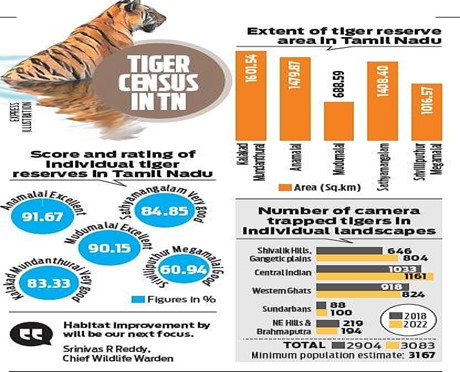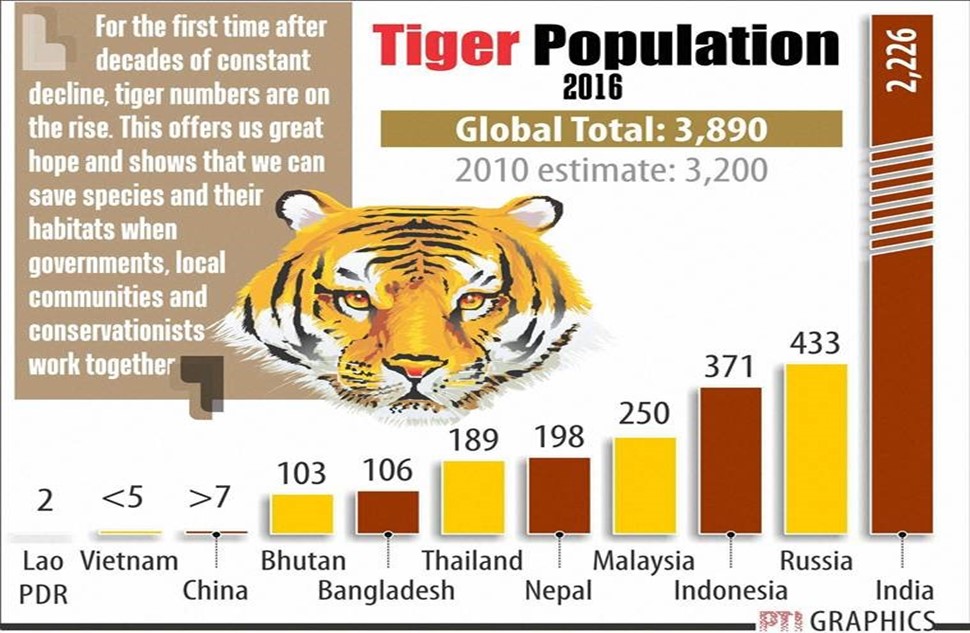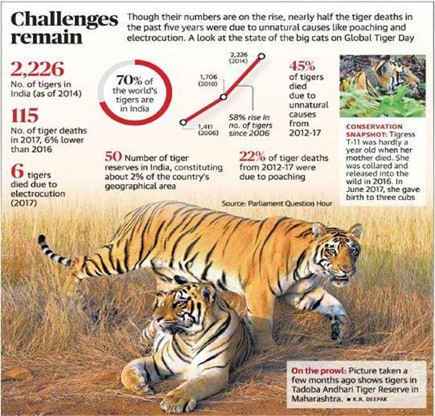PREVIOUS
Tiger population 2023 in India – Part 2
August 18 , 2023
596 days
2022
0
(இதன் தமிழ் வடிவத்திற்கு இங்கே சொடுக்கவும்)
Details of the Current Status of the Tiger in India
- Tiger Population in India in 2023 has been calculated by adding the big cats caught in the cameras.
- Those who have not been captured, calculated by statistical techniques.
- According to one of the scientists involved in the census exercise, Qamar Qureshi of the Wildlife Institute of India, 3,080 tigers have been caught in the camera traps.
- However, this is not complete data as the counting hasn’t finished yet.
- The actual number will include the State-wise break-up of tigers and the tigers outside the camera traps.
- The scientists also explained that the census report shows an estimated data of tiger population.
- And the mean value is highlighted as the final number.
- For example, as per Tiger Census 2018 Report, the minimum and maximum value of the range were 2,603 and 3,346, respectively.
- So, the outcome came as a mean value of 2,967, which is also the tiger population in India 2019.
- According to the tiger census 2023, India’s tiger population rises around 6% compared to the last data released in 2018.
- However, there has been a decline in the tiger population in the Western Ghats region.
- Despite this decline, there are reports suggesting that the major tiger populations in the Western Ghats remain stable.
- The Shivalik hills and Gangetic floodplains have seen the highest growth in tiger population in recent years.
- Central India and the northeastern hills have also witnessed a significant increase in the number of tigers.
- The Brahmaputra flood plains and the Sundarbans have also shown a positive trend in tiger population growth.
- These developments are encouraging and point towards the successful efforts of tiger conservation in India.
- The current estimate on tiger populations also does not provide information on the number of tigers residing outside of protected areas.
- These tigers are increasingly vulnerable to environmental threats and human-animal conflicts.
- The census report’s authors have warned that the growth of tiger populations is challenged in almost all of the five major tiger zones throughout the country.
- This is due to the escalating demands for infrastructure development.
- In areas like the Shivalik hills and Gangetic plains, tigers are growing in number outside of Tiger Reserves in the landscape.
- Therefore, states like Uttarakhand and Uttar Pradesh must invest in reducing conflict with tigers and mega herbivores.
- Wildlife habitats such as protected areas and corridors in the Central Indian highlands and Eastern Ghats are confronted with various threats.
- These include habitat encroachment, illegal poaching of tigers and their prey, excessive harvesting of non-timber forest produce, mining, conflicts between humans and wildlife, ever-expanding linear infrastructure, unregulated and illicit cattle grazing, human-initiated forest fires, and other reasons.
Increase in Tiger Population and its effects
- According to specialists, the majority of tigers in the country are concentrated in a few reserves that are nearing their maximum carrying capacity.
- Without the development of new areas as reserves, there may be obstacles to sustaining their population growth.
- India has recently relocated cheetahs from Africa and is now exploring international efforts to translocate big cats to other global locations, as per the reports.
- Discussions are underway with Cambodia, to create an appropriate habitat and relocate a few species to boost up tiger’s population.
- In Cambodia the tiger population has been wiped out due to illegal poaching.
Scientific approaches to Tiger Census
- The Tiger Census in India is conducted by the government every four years to assess the population of tigers in the country.
- The Indian government’s goal is to increase the tiger population to at least 3,000 individuals and maintain and improve their habitats to ensure the long-term survival of the species.
- Tiger census is an extensive exercise which involves a number of scientific approaches to counting individuals.
Methods to count tigers
Camera Trapping
- This involves setting up camera traps at strategic locations in tiger habitats to capture images of individual tigers.
- These images are then used to identify individual tigers based on their unique stripe patterns, which are similar to a human fingerprint.

DNA Analysis
- Hair or scat samples collected from tigers can be used to determine the species, sex, and individual identity of tigers through DNA analysis.
- This method is useful for estimating tiger populations in remote or hard-to-reach areas.
Pug Mark Counting
- This involves counting the pug marks (footprints) of tigers in a particular area to estimate the number of individuals present.
- This method is used in conjunction with other methods to validate the results and provide a more accurate estimate of the tiger population.

Direct Observation
- This involves direct observation of tigers in the wild by trained observers.
- This method is used to supplement other methods and provide additional information on the distribution and behaviour of tigers.
- The methods used for counting tigers are chosen based on the specific habitats and conditions in a given area.
- The results from multiple methods are often combined to provide a more accurate estimate of the tiger population.
- The tiger census in India is a collaborative effort involving multiple stakeholders.

Stakeholders of Tiger Census
National Tiger Conservation Authority (NTCA)
- The NTCA is the nodal agency responsible for the management and conservation of tigers in India.
- It provides technical and financial support to the states for conducting the tiger census.
State Forest Departments
- The state forest departments play a crucial role in conducting the tiger census by implementing field-level activities.
- It includes practices such as setting up camera traps, collecting samples, and training field staff.
Wildlife NGOs and Conservation Groups
- Wildlife NGOs and conservation groups often provide technical support and expertise to government agencies in conducting the tiger census.
- They also help in spreading awareness about the importance of tiger conservation and protection.
Researchers and Scientists
- Researchers and scientists from universities, research institutions, and wildlife organizations are involved in developing and implementing the methods used for counting tigers, analyzing the data, and interpreting the results.
Local Communities
- Especially those living near tiger habitats, are also involved in the tiger census by providing information about tiger sightings, assisting in collecting data, and participating in awareness programs.

Embracing & protecting the tiger as a symbol of national identity
- The tiger, being the national animal of a country, holds a special significance.
- Its status is a symbol of strength and beauty.
- It plays a crucial role in binding the country together, fostering a sense of national identity, pride, and unity among its people.
- It is representing a shared cultural heritage and historical significance.
- In many countries, the tiger has been an integral part of local myths, folklore, and traditional art forms for centuries.

- When a nation comes together to protect its national animal, it fosters a collective responsibility for safeguarding the environment.
- Tiger as a national symbol promotes a sense of national pride.
- Schools and institutions may incorporate tiger conservation into their curricula, raising awareness about environmental issues.
- A national animal has the power to unite a country in multiple ways.
- It connects people through shared culture and history.
- It inspires collective efforts, and serves as a catalyst for environmental education.
Leave a Reply
Your Comment is awaiting moderation.


